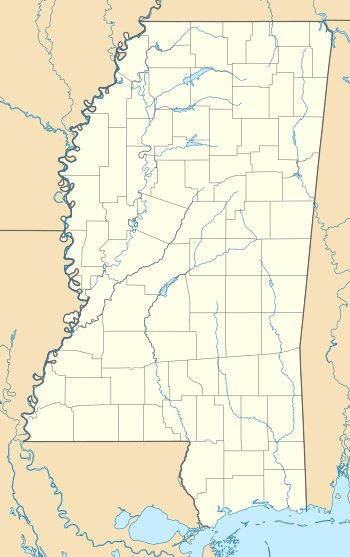Eureka School (Hattiesburg, Mississippi)
Eureka School, located at 412 East 6th Street in Hattiesburg, Mississippi, was constructed in 1921 as a public school for African Americans.[4] The school was the first brick school building for black students to be built in Mississippi.[5] The former school building, which now houses a civil rights museum,[5] was designated a Mississippi Landmark in 2005.
| Eureka School | |
|---|---|
_2015.jpg) Front facade in 2015 | |
| Location | 412 East 6th Street Hattiesburg, Mississippi[1] |
| Coordinates | 31.3347°N 89.2911°W |
| Built | 1921 |
| Governing body | Hattiesburg Convention Commission[2] |
Mississippi Landmark | |
| Designated | July 14, 2005 |
| Reference no. | 035-HAT-0309.2-ML[3] |
 Location of Eureka School in Mississippi | |
History
Construction of Eureka School was completed in September 1921, as a two-story brick building of about 27,000 sq ft (2,500 m2).[1] Funding was provided by a $75,000 bond issue.[4]
Eureka School was the only public school for African Americans in Hattiesburg from 1921 to 1949, serving grades 1 through 12.[4] Enrollment increased from 800 students in 1940 to 1,400 by 1947, requiring more school facilities. By 1949, a new high school for African Americans was built, but Eureka School continued to serve as an elementary school through desegregation, until 1987.[6]
After the public school closed in 1987, the building was used as an adult literacy center and storage facility for the Hattiesburg Public School District.[6]
Restoration
In 2008, a groundbreaking ceremony was held to begin restoration of Eureka School for use as an African American Heritage and Cultural Museum.[7] Funding for restoration was provided by grants through the Mississippi Department of Archives and History.[8][9][10]
On February 10, 2013, an EF-4 tornado passed through Hattiesburg.[11][12] During the storm, the roof of Eureka School was severely damaged.[1] By the end of August 2013, roof repairs had been completed.[13]
Restoration of the building's interior continued through 2014.[10] Multi-phase renovations proceeded as funds became available. In January 2017, plumbing and electrical repairs and improvements were being scheduled, as well as interior painting, to complete the building's renovation.[14]
References
- >"MDAH Historic Resources (Fact Sheet—Eureka School)". Mississippi Department of Archives and History. Retrieved 2015-01-12.
- Hattiesburg Convention Commission Retrieved 2015-01-14.
- "MDAH Historic Resources (Architectural—Eureka School)". Mississippi Department of Archives and History. Archived from the original on 2015-02-03. Retrieved 2015-01-12.
- Eureka School Restoration and Renewal Retrieved 2015-01-12.
- Jones, Albert C. "Mrs. Iola Williams' return to Hattiesburg a work in heritage tourism and revival of World War II-era USO Club". America, The Diversity Place. Archived from the original on 2020-01-19. Retrieved 2020-01-20.
- Telling the Story of African-Americans in Hattiesburg, Mississippi: A Case Study of Socially Sustainable Tourism? Southeastern Geographer 2013 53(4):428–454 Retrieved 2015-01-12.
- Eureka School Future Restoration Retrieved 2015-01-14.
- MDAH 2007 Community Heritage Preservation Grant Winners Archived 2007-08-16 at the Wayback Machine Retrieved 2015-01-14.
- MDAH announces grants awarded to civil rights sites (2011) Retrieved 2015-01-14.
- MDAH awards $2M in grants. Hattiesburg American (December 7, 2014) Retrieved 2015-01-12.
- Pine Belt Tornado Event Retrieved 2015-01-12.
- Tornado hits Hattiesburg, Miss.—USA Today (February 11, 2013) Retrieved 2015-01-12.
- Eureka School damage almost repaired. Hattiesburg American (August 5, 2013) Archived January 18, 2015, at Archive.today Retrieved 2015-01-12.
- Work to continue on Eureka School. Hattiesburg American (January 6, 2017) Retrieved 2017-03-25.
External links
- Historic Hattiesburg school recovers from February tornado Retrieved 2015-01-12.